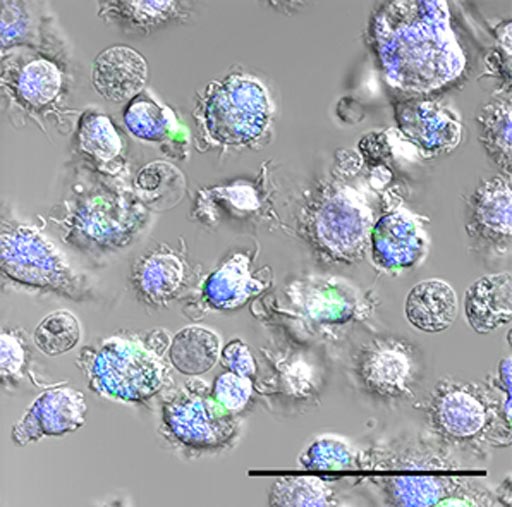Assay Determines Suitability of Nanoparticles for In Vivo Use
By LabMedica International staff writers
Posted on 28 Feb 2017
A team of Swiss researchers has developed a flow cytometry-based test to determine whether specific types of nanoparticles are suitable for use in humans or animals.Posted on 28 Feb 2017
Nanoparticles as carriers of drugs, genetic material, or other substances of biomedical interest are under investigation in many laboratories. However, their interaction with immune cells has been difficult to predict. Macrophages are among the first type of cells that take up nanoparticles, mediating inflammation and thus immunological responses. A recent study described a highly reproducible screening method to study the interaction of nanoparticles with macrophages.

Image: Macrophages with ingested nanoparticles (green) (Photo courtesy of the Bourquin Laboratory, University of Geneva).
Investigators at the University of Geneva and the University of Fribourg reported in the February 2, 2017, online edition of the journal Nanoscale that they had developed a flow cytometry-based assay that could determine for a single nanoparticle sample whether the nanoparticles were taken up by macrophages, whether the nanoparticles caused death of the macrophages, and whether the nanoparticles triggered an inflammatory immune response.
To perform the assay, macrophages were brought into contact with the nanoparticles for 24 hours, and were then evaluated in a flow cytometer. The fluorescence emitted by the macrophages made it possible to count them and characterize their activation levels. Since the particles themselves were fluorescent, the investigators could also measure the amount of particles ingested by the macrophages. Thus, the three elements could be determined simultaneously in two or three days on a very small amount of particles.
"Researchers can spend years developing a nanoparticle, without knowing what impact it will have on a living organism," said senior author Dr. Carole Bourquin, professor of medicine at the University of Geneva. "So there was a real need to design an effective screening method that could be implemented at the beginning of the development process. Indeed, if the nanoparticles aren’t compatible, several years of research were simply thrown away."




 assay.jpg)









